Fluoroindate Glass Co-Doped with Yb3+/Ho3+ as a 2.85 μm Luminescent Source for MID-IR Sensing
Abstract
:1. Introduction
2. Materials and Methods
3. Results and Discussion
3.1. Infrared Transmission Spectrum and Hydroxide Group Content
3.2. Luminescence Properties
3.3. Energy Transfer Mechanism between Yb3+and Ho3+, Energy Transfer Efficiency
4. Conclusions
Author Contributions
Funding
Institutional Review Board Statement
Informed Consent Statement
Data Availability Statement
Conflicts of Interest
References
- Tittel, F.K.; Richter, D.; Fried, A. Mid-Infrared Laser Applications in Spectroscopy. In Solid-State Mid-Infrared Laser Sources; Sorokina, I.T., Vodopyanov, K.L., Eds.; Springer: Berlin/Heidelberg, Germany, 2003; pp. 458–529. ISBN 978-3-540-36491-7. [Google Scholar]
- Bernier, M.; Michaud-Belleau, V.; Levasseur, S.; Fortin, V.; Genest, J.; Vallée, R. All-fiber DFB laser operating at 2.8 μm. Opt. Lett. 2014, 40, 81. [Google Scholar] [CrossRef] [PubMed]
- Zhou, P.; Wang, X.; Ma, Y.; Lü, H.; Liu, Z. Review on recent progress on mid-infrared fiber lasers. Laser Phys. 2012, 22, 1744–1751. [Google Scholar] [CrossRef]
- Jackson, S.D. Towards high-power mid-infrared emission from a fibre laser. Nat. Photon. 2012, 6, 423–431. [Google Scholar] [CrossRef]
- Duarte, F.J. Tunable Laser Applications; Optical Science and Engineering; CRC Press: Boca Raton, FL, USA, 2008; ISBN 9781420060584. [Google Scholar]
- Xue, T.X.T.; Zhang, L.Z.L.; Wen, L.W.L.; Liao, M.L.M.; Hu, L.H.L. Er3+-doped fluorogallate glass for mid-infrared applications. Chin. Opt. Lett. 2015, 13, 81602–81606. [Google Scholar] [CrossRef]
- Jia, S.; Li, C.; Zhao, Z.; Yao, C.; Jia, Z.; Qin, G.; Ohishi, Y.; Qin, W. Er3+-doped ZnF2-BaF2-SrF2-YF3 fluoride glasses for 2.7 μm laser applications. Mater. Lett. 2018, 227, 97–99. [Google Scholar] [CrossRef]
- Majewski, M.R.; Woodward, R.I.; Carreé, J.-Y.; Poulain, S.; Poulain, M.; Jackson, S.D. Emission beyond 4 μm and mid-infrared lasing in a dysprosium-doped indium fluoride (InF3) fiber. Opt. Lett. 2018, 43, 1926–1929. [Google Scholar] [CrossRef] [PubMed] [Green Version]
- Board, Space Studies, and National Research Council. Earth Science and Applications from Space: National Imperatives for the Next Decade and Beyond; National Academies Press: Cambridge, MA, USA, 2007; ISBN 9780309103879. [Google Scholar]
- Walsh, B.M.; Lee, H.R.; Barnes, N.P. Mid infrared lasers for remote sensing applications. J. Lumin. 2016, 169, 400–405. [Google Scholar] [CrossRef]
- Yang, Z.; Xu, S.; Hu, L.; Jiang, Z. Thermal analysis and optical properties of Yb3+/Er3+-codoped oxyfluoride germanate glasses. J. Opt. Soc. Am. B 2004, 21, 951–957. [Google Scholar] [CrossRef]
- Berrou, A.; Kieleck, C.; Eichhorn, M. Mid-infrared lasing from Ho3+ in bulk InF_3 glass. Opt. Lett. 2015, 40, 1699. [Google Scholar] [CrossRef]
- Wei, C.; Shi, H.; Luo, H.; Zhang, H.; Lyu, Y.; Liu, Y. 34 nm-wavelength-tunable picosecond Ho3+/Pr3+-codoped ZBLAN fiber laser. Opt. Express 2017, 25, 19170–19178. [Google Scholar] [CrossRef]
- Jia, S.; Jia, Z.; Yao, C.; Zhang, L.; Feng, Y.; Qin, G.; Ohishi, Y.; Qin, W. 2875 nm Lasing From Ho3+-Doped Fluoroindate Glass Fibers. IEEE Photon. Technol. Lett. 2017, 30, 323–326. [Google Scholar] [CrossRef]
- Théberge, F.; Daigle, J.-F.; Vincent, D.; Mathieu, P.; Fortin, J.; Schmidt, B.E.; Thiré, N.; Légaré, F. Mid-infrared supercontinuum generation in fluoroindate fiber. Opt. Lett. 2013, 38, 4683–4685. [Google Scholar] [CrossRef]
- Bei, J.; Monro, T.M.; Hemming, A.; Ebendorff-Heidepriem, H. Reduction of scattering loss in fluoroindate glass fibers. Opt. Mater. Express 2013, 3, 1285–1301. [Google Scholar] [CrossRef] [Green Version]
- Doualan, J.; Girard, S.; Haquin, H.; Adam, J.; Montagne, J. Spectroscopic properties and laser emission of Tm doped ZBLAN glass at 1.8 μm. Opt. Mater. 2003, 24, 563–574. [Google Scholar] [CrossRef]
- Zhu, X.; Peyghambarian, N. High-Power ZBLAN Glass Fiber Lasers: Review and Prospect. Adv. Optoelectron. 2010, 2010, 1–23. [Google Scholar] [CrossRef] [Green Version]
- Trolès, J.; Brilland, L. Chalcogenide microstructured optical fibres for mid-IR applications. Comptes Rendus Phys. 2017, 18, 19–23. [Google Scholar] [CrossRef]
- Swiderski, J.; Théberge, F.; Michalska, M.; Mathieu, P.; Vincent, D. High average power supercontinuum generation in a fluoroindate fiber. Laser Phys. Lett. 2014, 11, 015106. [Google Scholar] [CrossRef]
- Vallon, R.; Soutade, J.; Vérant, J.-L.; Meyers, J.; Paris, S.; Mohamed, A. A Compact Tunable Diode Laser Absorption Spectrometer to Monitor CO2 at 2.7 µm Wavelength in Hypersonic Flows. Sensors 2010, 10, 6081–6091. [Google Scholar] [CrossRef]
- Gomes, L.; Fortin, V.; Bernier, M.; Vallée, R.; Poulain, S.; Poulain, M.; Jackson, S.D. The basic spectroscopic parameters of Ho3+-doped fluoroindate glass for emission at 3.9 μm. Opt. Mater. 2016, 60, 618–626. [Google Scholar] [CrossRef]
- Ribeiro, C.T.M.; Zanatta, A.; Nunes, L.A.O.; Messaddeq, Y.; Aegerter, M.A. Optical spectroscopy of Er3+ and Yb3+ co-doped fluoroindate glasses. J. Appl. Phys. 1998, 83, 2256–2260. [Google Scholar] [CrossRef] [Green Version]
- De Sousa, D.F.; Zonetti, L.F.C.; Bell, M.J.V.; Lebullenger, R.; Hernandes, A.C.; Nunes, L.A.O. Er3+:Yb3+ codoped lead fluoroindogallate glasses for mid infrared and upconversion applications. J. Appl. Phys. 1999, 85, 2502–2507. [Google Scholar] [CrossRef]
- Wang, R.; Zhao, H.; Zhang, M.; Zhang, J.; Jia, S.; Zhang, J.; Peng, H.; Brambilla, G.; Wang, S.; Wang, P. Enhancement mechanisms of Tm3+-codoping on 2 μm emission in Ho3+ doped fluoroindate glasses under 888 nm laser excitation. Ceram. Int. 2020, 46, 6973–6977. [Google Scholar] [CrossRef]
- Kochanowicz, M.; Lesniak, M.; Zmojda, J.; Miluski, P.; Baranowska, A.; Ragin, T.; Kuwik, M.; Pisarski, W.A.; Pisarska, J.; Dorosz, J.; et al. Structure, luminescence and energy transfer of fluoroindate glasses co-doped with Er3+/Ho3+. Ceram. Int. 2020, 46, 26403–26409. [Google Scholar] [CrossRef]
- Ni, Y.; Wu, H.; Mao, M.; Li, W.; Wang, Z.; Ma, J.; Chen, S.; Huang, C. Growth and characterization of mid-far infrared optical material CdSe crystal. Opt. Mater. Express 2018, 8, 1796–1805. [Google Scholar] [CrossRef]
- Cao, W.; Wang, T.; Huang, F.; Ye, R.; Lei, R.; Tian, Y.; Zhang, J.; Xu, S. Analysis of mid-infrared photoluminescence around 2.85 μm in Yb3+/Ho3+ co-doped synthetic silica-germanate glass. Infrared Phys. Technol. 2018, 89, 363–368. [Google Scholar] [CrossRef]
- Wang, Y.; Xu, C.; Zhang, Z.; Zheng, C.; Pei, J.; Sun, L. Enhanced 1–5 μm near- and mid-infrared emission in Ho3+/Yb3+ codoped TeO2-ZnF2 oxyfluorotellurite glasses. J. Rare Earths 2020, 38, 1044–1052. [Google Scholar] [CrossRef]
- Cao, W.; Huang, F.; Ye, R.; Cai, M.; Lei, R.; Zhang, J.; Xu, S.; Zhang, X. Structural and fluorescence properties of Ho3+/Yb3+ doped germanosilicate glasses tailored by Lu2O3. J. Alloys Compd. 2018, 746, 540–548. [Google Scholar] [CrossRef]
- Zhang, J.; Lu, Y.; Cai, M.; Tian, Y.; Huang, F.; Xu, S. Highly Efficient 2.84 μm Emission in Ho3+/Yb3+ Co-Doped Tellurite–Germanate Glass for Mid-Infrared Laser Materials. IEEE Photon. Technol. Lett. 2017, 29, 1498–1501. [Google Scholar] [CrossRef]
- Ragin, T.; Baranowska, A.; Kochanowicz, M.; Zmojda, J.; Miluski, P.; Dorosz, D. Study of Mid-Infrared Emission and Structural Properties of Heavy Metal Oxide Glass and Optical Fibre Co-Doped with Ho3+/Yb3+ Ions. Materials 2019, 12, 1238. [Google Scholar] [CrossRef] [Green Version]
- Zhao, G.; Tian, Y.; Fan, H.; Zhang, J.; Hu, L. Efficient 2.7-μm emission in Er3+-doped bismuth germanate glass pumped by 980-nm laser diode. Chin. Opt. Lett. 2012, 10, 91601. [Google Scholar] [CrossRef]
- Zhou, B.; Wei, T.; Cai, M.; Tian, Y.; Zhou, J.; Deng, D.; Xu, S.; Zhang, J. Analysis on energy transfer process of Ho3+ doped fluoroaluminate glass sensitized by Yb3+ for mid-infrared 2.85 μm emission. J. Quant. Spectrosc. Radiat. Transf. 2014, 149, 41–50. [Google Scholar] [CrossRef]
- Saad, M. Fluoride Glass Fiber: State of the Art. In Proceedings of the Fiber Optic Sensors and Applications VI, Orlando, FL, USA, 27 April 2009; Volume 7316, pp. 170–185. [Google Scholar]
- Cai, M.; Zhou, B.; Tian, Y.; Zhou, J.; Xu, S.; Zhang, J. Broadband mid-infrared 2.8 μm emission in Ho3+/Yb3+-codoped germanate glasses. J. Lumin. 2016, 171, 143–148. [Google Scholar] [CrossRef]
- Tian, Y.; Wei, T.; Chen, F.; Jing, X.; Zhang, J.; Xu, S. Fluorescence characteristics and energy transfer of ytterbium-sensitized erbium-doped fluorophosphate glass for amplifier applications. J. Quant. Spectrosc. Radiat. Transf. 2014, 133, 311–318. [Google Scholar] [CrossRef]
- Cao, R.; Lu, Y.; Tian, Y.; Huang, F.; Guo, Y.; Xu, S.; Zhang, J. 2 μm emission properties and nonresonant energy transfer of Er3+ and Ho3+ codoped silicate glasses. Sci. Rep. 2016, 6, 37873. [Google Scholar] [CrossRef] [Green Version]
- Zhao, C.; Hang, Y.; Zhang, L.; Yin, J.; Hu, P.; Ma, E. Polarized spectroscopic properties of Ho3+-doped LuLiF4 single crystal for 2 μm and 2.9 μm lasers. Opt. Mater. 2011, 33, 1610–1615. [Google Scholar] [CrossRef]
- Wei, S.; Xu, Y.; Dai, S.; Zhou, Y.; Lin, C.; Zhang, P. Theoretical studies on mid-infrared amplification in Ho3+-doped chalcogenide glass fibers. Phys. B Condens. Matter 2013, 416, 64–68. [Google Scholar] [CrossRef]
- Kochanowicz, M.; Zmojda, J.; Miluski, P.; Pisarska, J.; Pisarski, W.A.; Dorosz, D. NIR to visible upconversion in double—Clad optical fiber co-doped with Yb3+/Ho3+. Opt. Mater. Express 2015, 5, 1505. [Google Scholar] [CrossRef]
- Cao, W.; Wang, T.; Huang, F.; Ye, R.; Zhang, X.; Lei, R.; Tian, Y.; Zhang, J.; Xu, S. Positive influence of Sm3+ ion on the ~ 2.85 µm emission in Yb3+/Ho3+ co-doped silica-germanate glass. J. Lumin. 2018, 201, 98–103. [Google Scholar] [CrossRef]
- Pisarska, J.; Kuwik, M.; Górny, A.; Kochanowicz, M.; Zmojda, J.; Dorosz, J.; Dorosz, D.; Sitarz, M.; Pisarski, W.A. Holmium doped barium gallo-germanate glasses for near-infrared luminescence at 2000 nm. J. Lumin. 2019, 215, 116625. [Google Scholar] [CrossRef]
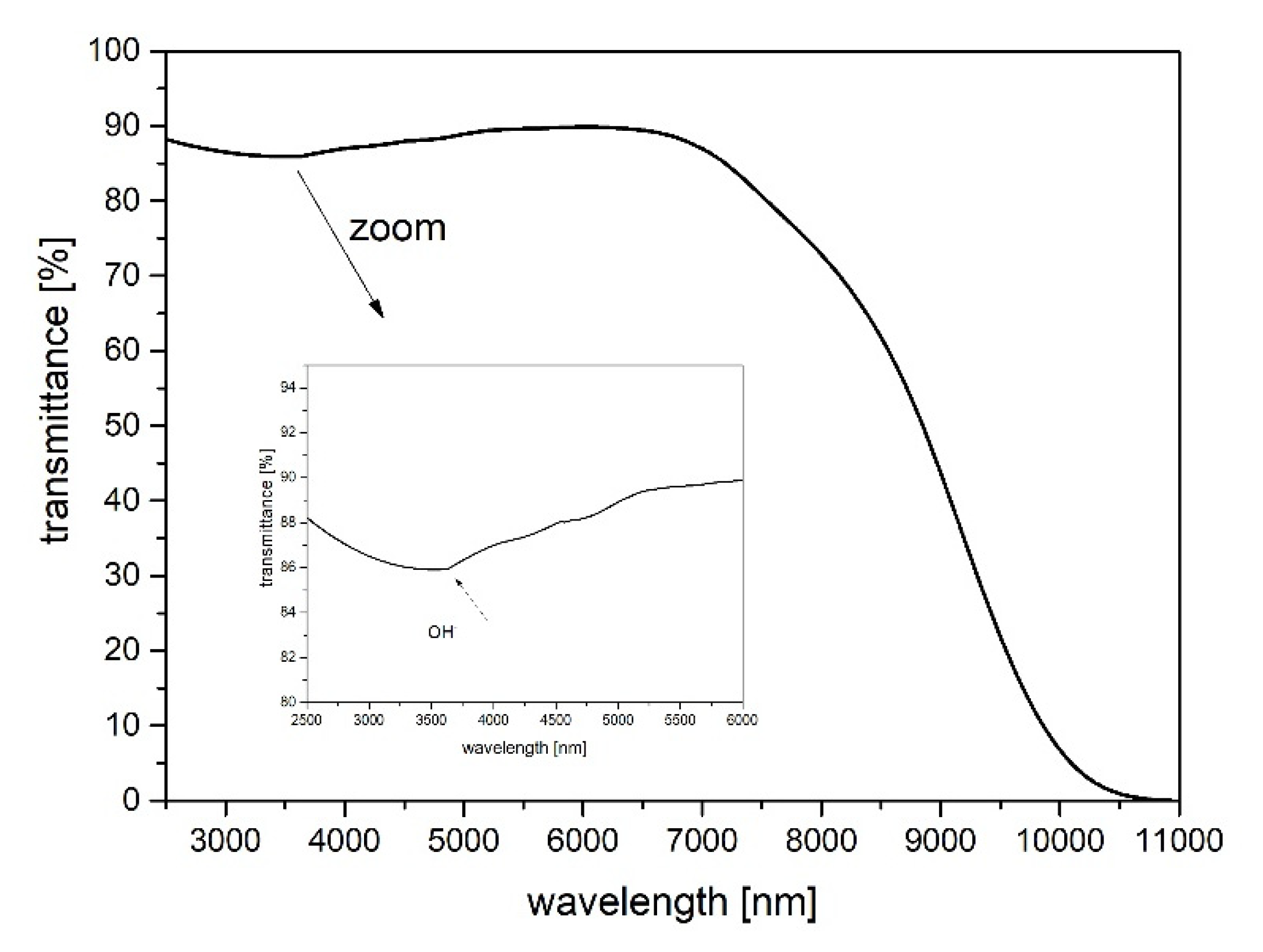
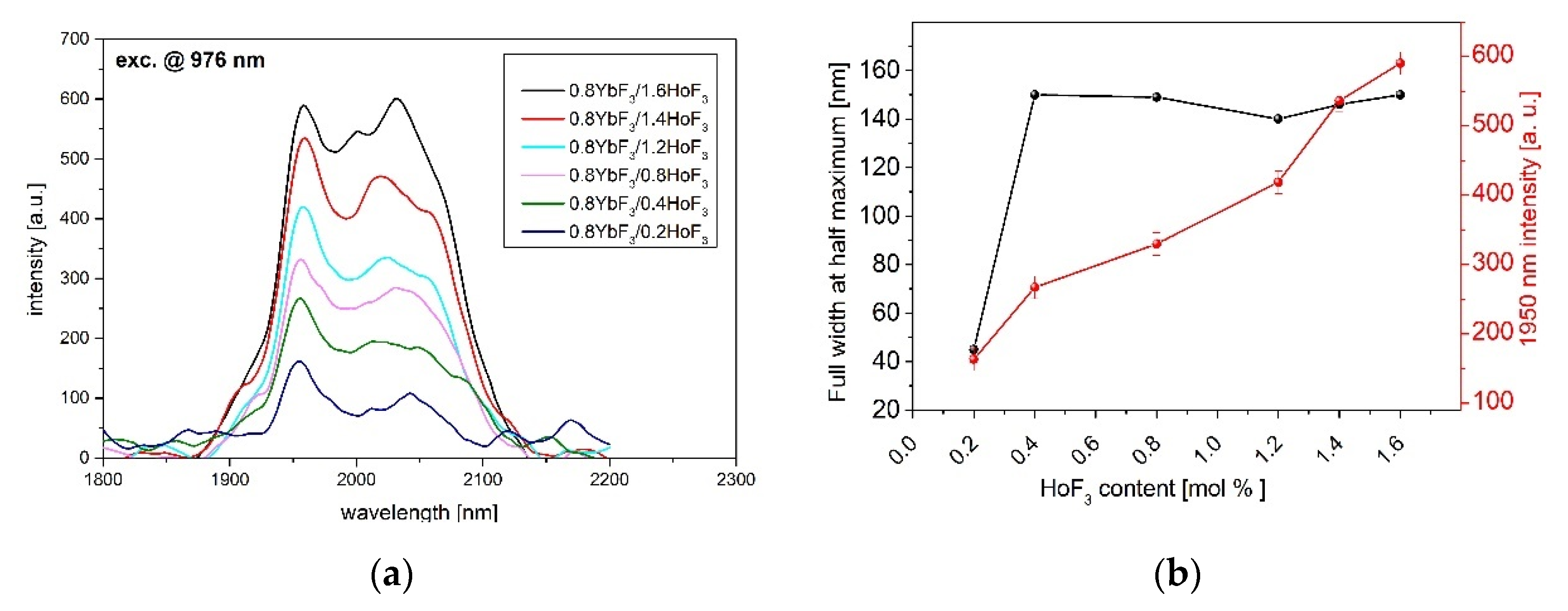
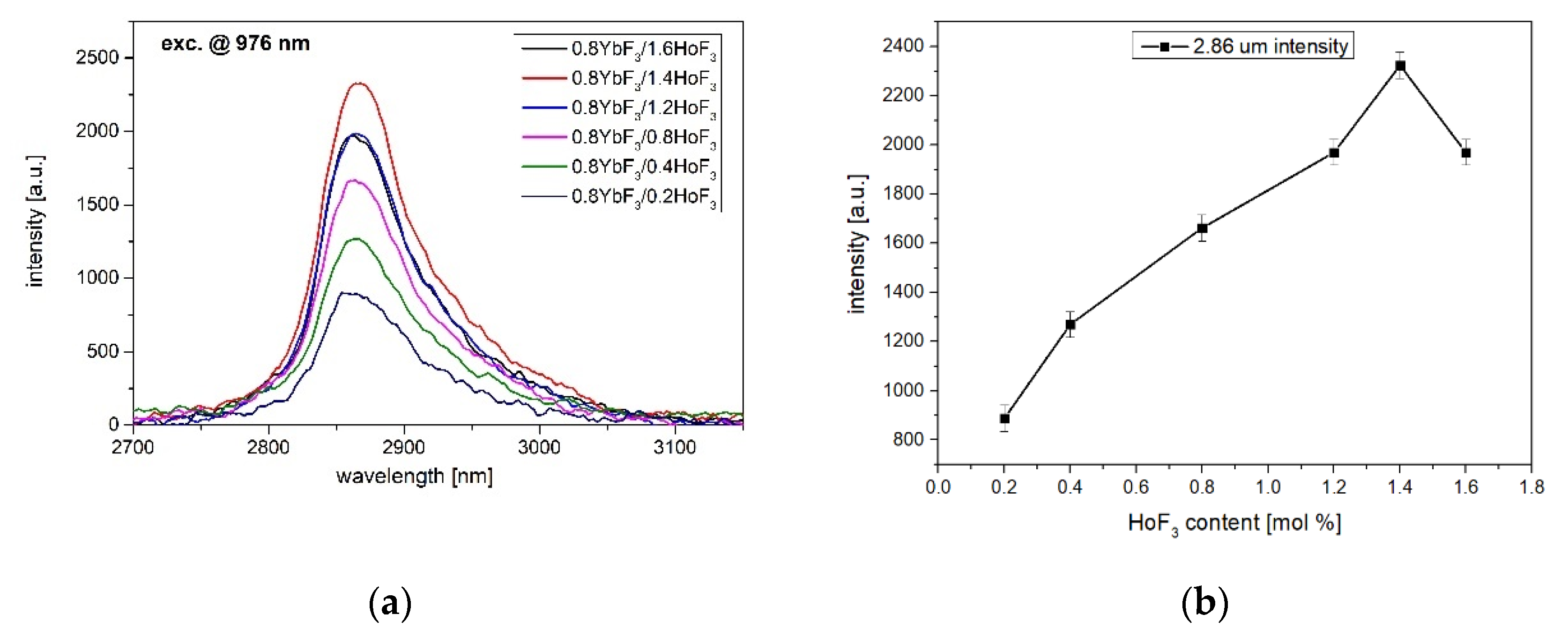
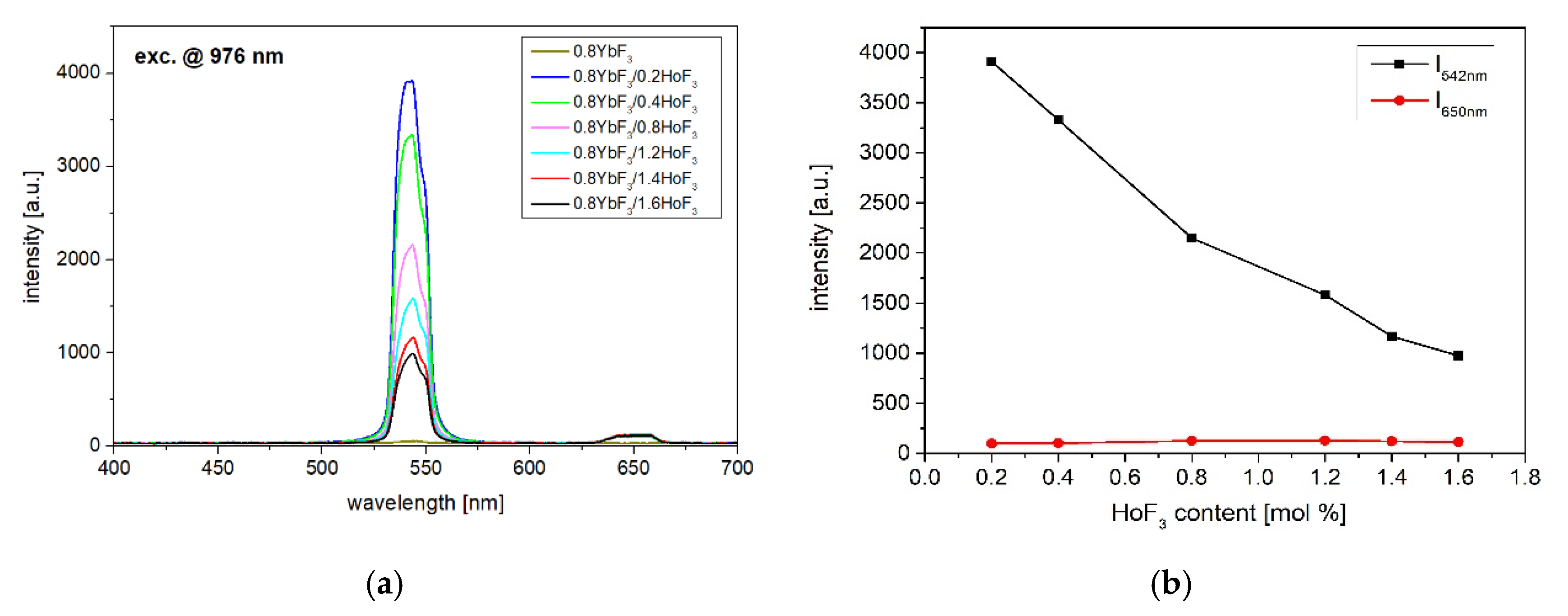
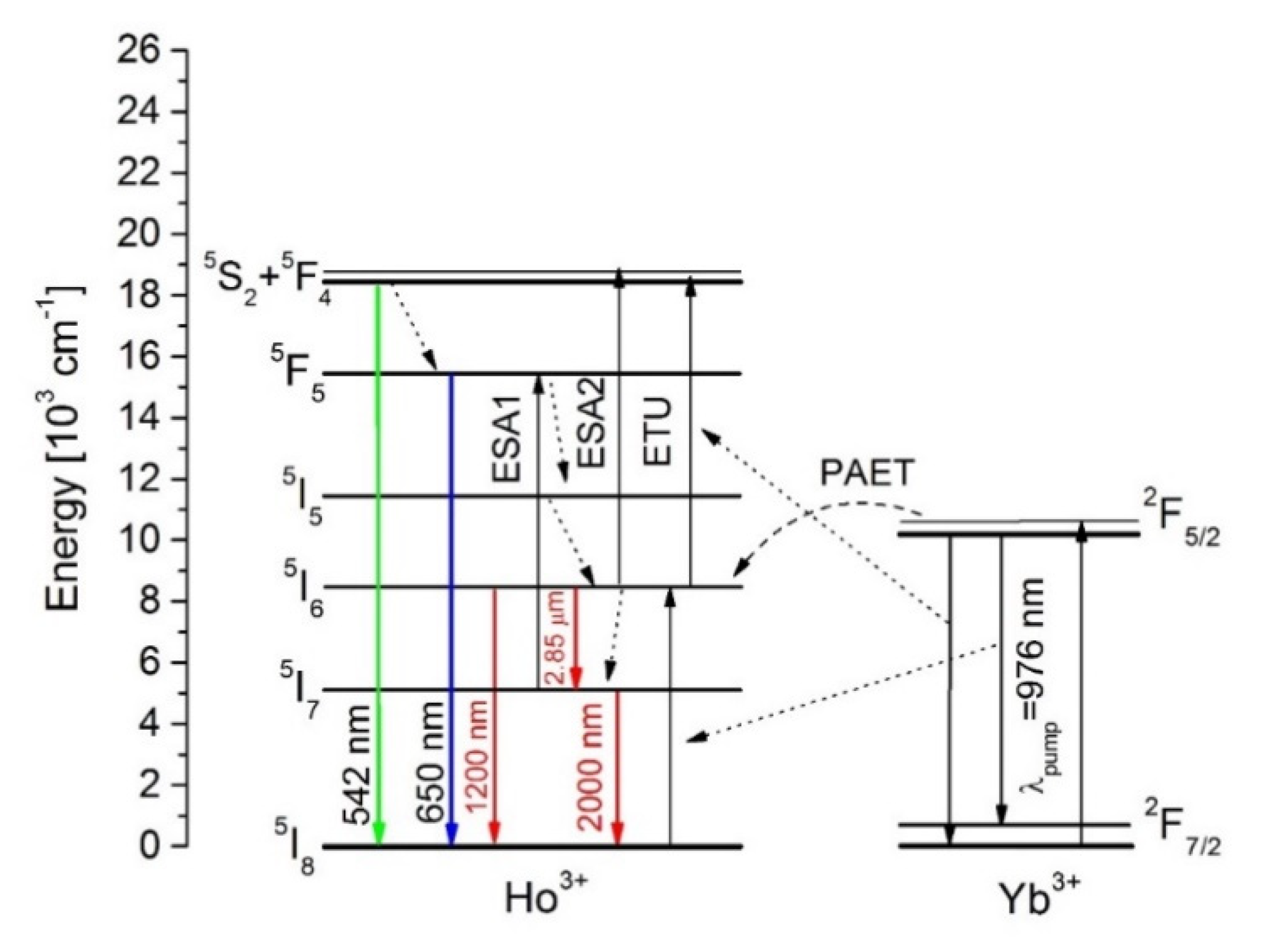

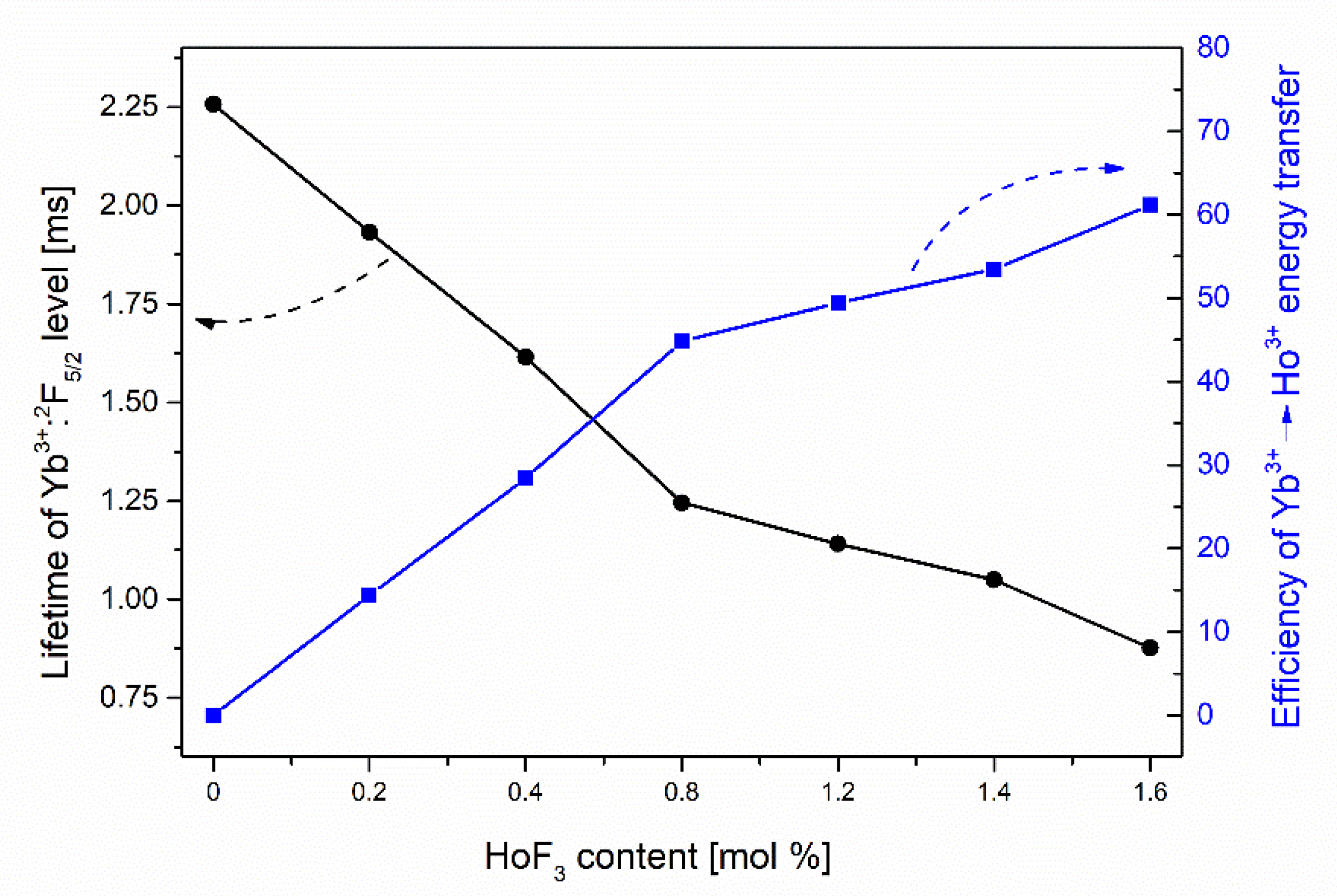
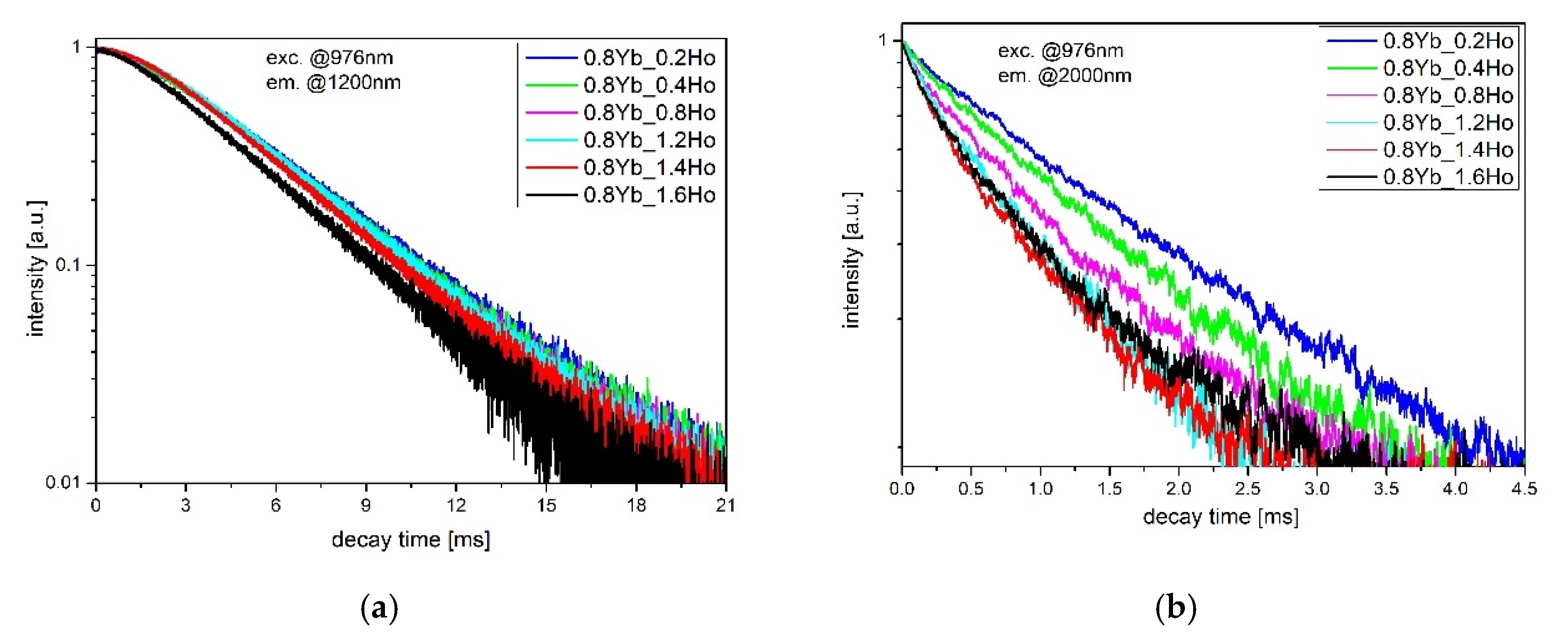
| Glass Sample | Co-Dopants | |
|---|---|---|
| (x) YbF3 [mol%] | (y) HoF3 [mol%] | |
| 0.8Yb | 0.8 | 0 |
| 0.8Yb-0.2Ho | 0.8 | 0.2 |
| 0.8Yb-0.4Ho | 0.8 | 0.4 |
| 0.8Yb-0.8Ho | 0.8 | 0.8 |
| 0.8Yb-1.2Ho | 0.8 | 1.2 |
| 0.8Yb-1.4Ho | 0.8 | 1.4 |
| 0.8Yb-1.6Ho | 0.8 | 1.6 |
| Material | Dopants | FWHM | Ref. |
|---|---|---|---|
| LuLiF4 crystal | 1.58 × 1020 Ho3+ (ions/cm3) | <50 nm | [39] |
| Chalcogenide glass | 1Ho2S3 (wt.%) | 43 nm | [40] |
| Germanate glass | 1Yb2O3/0.17Ho2O3 (mol%) | 110 nm | [36] |
| Bismuth-germanate glass | 0.75Yb2O3/0.25Ho2O3 (mol%) | 71 nm | [32] |
| Fluoroaluminate glass | 2YbF3/0.5HoF3 (mol%) | 59 nm | [34] |
| Fluoroindate glass | 0.8YbF3/1.4HoF3 (mol%) | 83 nm | This work |
| Glass Code | Lifetime @1200 nm [ms] | Lifetime @2000 nm [ms] |
|---|---|---|
| 0.8Yb_0.2Ho | 5.13 | 1.69 |
| 0.8Yb_0.4Ho | 5.01 | 1.41 |
| 0.8Yb_0.8Ho | 4.84 | 1.10 |
| 0.8Yb_1.2Ho | 4.98 | 0.89 |
| 0.8Yb_1.4Ho | 4.71 | 0.77 |
| 0.8Yb_1.6Ho | 4.27 | 0.88 |
Publisher’s Note: MDPI stays neutral with regard to jurisdictional claims in published maps and institutional affiliations. |
© 2021 by the authors. Licensee MDPI, Basel, Switzerland. This article is an open access article distributed under the terms and conditions of the Creative Commons Attribution (CC BY) license (http://creativecommons.org/licenses/by/4.0/).
Share and Cite
Kochanowicz, M.; Zmojda, J.; Baranowska, A.; Kuwik, M.; Starzyk, B.; Lesniak, M.; Miluski, P.; Pisarski, W.A.; Pisarska, J.; Dorosz, J.; et al. Fluoroindate Glass Co-Doped with Yb3+/Ho3+ as a 2.85 μm Luminescent Source for MID-IR Sensing. Sensors 2021, 21, 2155. https://doi.org/10.3390/s21062155
Kochanowicz M, Zmojda J, Baranowska A, Kuwik M, Starzyk B, Lesniak M, Miluski P, Pisarski WA, Pisarska J, Dorosz J, et al. Fluoroindate Glass Co-Doped with Yb3+/Ho3+ as a 2.85 μm Luminescent Source for MID-IR Sensing. Sensors. 2021; 21(6):2155. https://doi.org/10.3390/s21062155
Chicago/Turabian StyleKochanowicz, Marcin, Jacek Zmojda, Agata Baranowska, Marta Kuwik, Bartłomiej Starzyk, Magdalena Lesniak, Piotr Miluski, Wojciech A. Pisarski, Joanna Pisarska, Jan Dorosz, and et al. 2021. "Fluoroindate Glass Co-Doped with Yb3+/Ho3+ as a 2.85 μm Luminescent Source for MID-IR Sensing" Sensors 21, no. 6: 2155. https://doi.org/10.3390/s21062155






